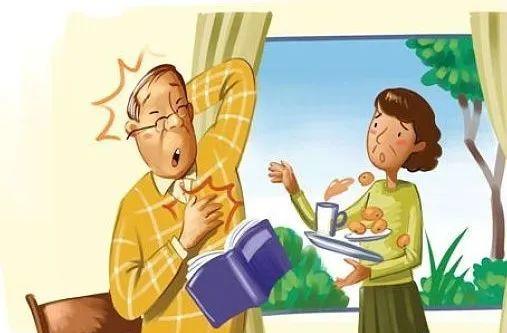Recently, 1 video appeared on the web. In the video, a taxi driver, on the road, hit the guardrail with his car, climbed out of the car, and directly collapsed on the ground. After emergency treatment, the driver was taken to the hospital, and finally diagnosed with diabetic hyperosmolar hyperglycemia, the cause of the accident was a sudden change in vision, unable to see the target in front of him. After watching the video, many people with diabetes are no longer calm, muttering to themselves, is diabetes so bad? Can I still drive in the future? Hyperosmolar hyperglycemia, what is the condition? How is it caused? Let's solve your doubts now.

Hyperosmolar hyperglycemia is a diabetic emergency, which is mainly manifested by a sudden increase in blood glucose, polyuria, polydipsia, fatigue, and visual impairment, as well as symptoms of dehydration, including weakness, anorexia, leg cramps, dizziness, drowsiness, dry skin and lack of elasticity, cold limbs, hypotension, tachycardia, and shock. You can imagine what would happen if these symptoms suddenly appeared during the driving process.
Hyperosmolar hyperglycemia, symptoms of an average duration of 12 days, in addition to the above symptoms, may also cause mesenteric ischemia, causing abdominal pain, patients may also have different degrees of neurological abnormalities, such as unilateral or bilateral motor or sensory loss, aphasia, muscle spasms, tremors, etc. In addition, epilepsy may occur in 15% of patients, coma occurs in 10% of patients, and cerebral edema, thrombosis, and vascular embolism may occur. In this diabetic emergency, the case fatality rate is about 30% to 40%.
Hyperosmolar hyperglycemia is a sudden increase in blood glucose due to insufficient insulin secretion in diabetic patients under the induced action, aggravating metabolic disorders and triggering a series of symptoms. The main pathological change is the increase in blood osmolality, which leads to severe dehydration of the body. Usually, hyperosmolar hyperglycemia will occur in about 10 days, such as thirst, polyuria, fatigue and other symptoms, and then severe symptoms will appear. This process, like pickled radish, puts a little more salt, the osmotic pressure rises, and the water in the radish will be sucked out. Hyperosmolar hyperglycemia, that is, the concentration of glucose in the blood is too high, which sucks out the water in the body tissues, organs, and even the brain, and falls into a hyperosmolar coma for about 48 hours.
Hyperosmolar hyperglycemia, the pathogenesis process mainly involves 3 factors, the first, because the thirst center is insensitive, can not stimulate people to drink water, or due to the need to force themselves to limit drinking water due to work, due to severe dehydration, resulting in increased blood sodium levels. 2nd, in stressful states such as infection or cerebrovascular accident, the secretion of catecholamines and glucocorticoids increases, inhibits insulin secretion, leading to a significant increase in blood glucose levels and osmolality. Third, after the blood glucose level rises, it causes an osmotic diuretic reaction, the loss of water is more than the excretion of salt, coupled with the low blood volume caused by secondary hyperaldosteronism, so that the discharge of sodium is further reduced, and the osmotic pressure is therefore significantly increased. Simply put, I pickled my body like a radish.
Hyperosmolar hyperglycemia occurs more often in the elderly, with 30% to 40% of patients with blood glucose abnormalities but not diagnosed with diabetes. Not knowing if you have diabetes is an important cause of the tragedy. Causes of hyperosmolar hyperglycemia include harsh environments such as high or low temperatures, trauma, infections, acute illness, severe inadequate water intake, extensive loss of water due to diarrhea or vomiting, excessive sugar intake or glucose transfusion, and diuretic medications. The master who drove the taxi was a hypertensive patient, took a drug with a strong diuretic effect, the climate was humid, he did not dare to drink water because he was driving, which induced hyperosmolar hyperglycemia, did not recognize in time, and suddenly blurred vision and indifference, resulting in an accident.
The diagnosis of hyperosmolar hyperglycemia needs to be judged comprehensively by combining symptoms and examination results, and the main indicators are blood glucose exceeding 600 mg/dL and effective plasma osmolality exceeding 320mOsm/kg. Suspected hyperosmolar hyperglycemia, should promptly seek medical treatment or call for emergency treatment, rescue measures are mainly to replenish blood volume, restore normal renal perfusion, promote the decline of serum sodium concentration and osmolality. After fluid replenishment, insulin therapy, potassium supplementation, and treatment of complications are required. If the patient does not develop a coma, he should actively drink water, and at the same time, it is necessary to strengthen monitoring and avoid the use of drugs that aggravate the impairment of renal function. To cope with hyperosmolar hyperglycemia, the focus is on strengthening prevention and identification, early detection, and early treatment.
It is worth noting that the driving requirements of diabetics have not been taken seriously here, while the experience elsewhere is that people who have experienced hypoglycemic symptoms are required not to drive for 6 to 12 months, and that the resumption of driving requires doctor's approval. Therefore, we can only rely on ourselves to strengthen safety awareness, often driving, especially people who drive for a long time, should understand their blood sugar levels, to prevent on the road, because of the sudden rise in blood sugar or low blood sugar, and cause diabetic emergencies, leading to traffic accidents.
Whoever loves, pass on health to whom.
Your health, my concern. Professionals observe health from a scientific and humanistic perspective, including a series of express reports, details, reminders, doubts, observations, opinions, historical stories, etc., with the content of the original works of the author Wei Hongling and the team. All forms of misappropriation and reproduction without permission will be refused, otherwise they will be prosecuted in accordance with relevant laws.